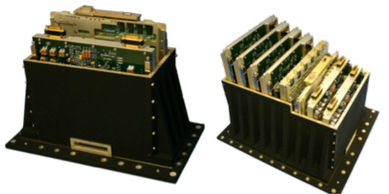
There where some guesses for my reader challenge, but Pape was correct: it’s a Cisco 18400 IRIS router. IRIS stands for Internet Routing In Space, and this router is a module for a satellite. A quick overview:
- It runs IOS, and can be remotely upgraded. Considering the cost to get someone physically near the router, that’s a huge advantage.
- It has extended VOIP Services like Cisco Unified Communications Manager Express, improving the latency for voice calls.
- It can exchange routing updates with other satellites with this module, and even routers on the planet surface. This way, direct connectivity between satellites becomes much easier.
- A full feature set: QoS, security, IPv6, OSPF, BGP, SNMP,…
- High radiation tolerance, which is mandatory in space.
- Gigabit-capable interfaces, although these interface go directly into satellite circuitry or antennae. Effective throughput is around 250 Mbps according to the data sheet.
This is most likely nothing I will ever have the chance to work with in this lifetime, nor something I will find on eBay. An impressive piece of technology!

